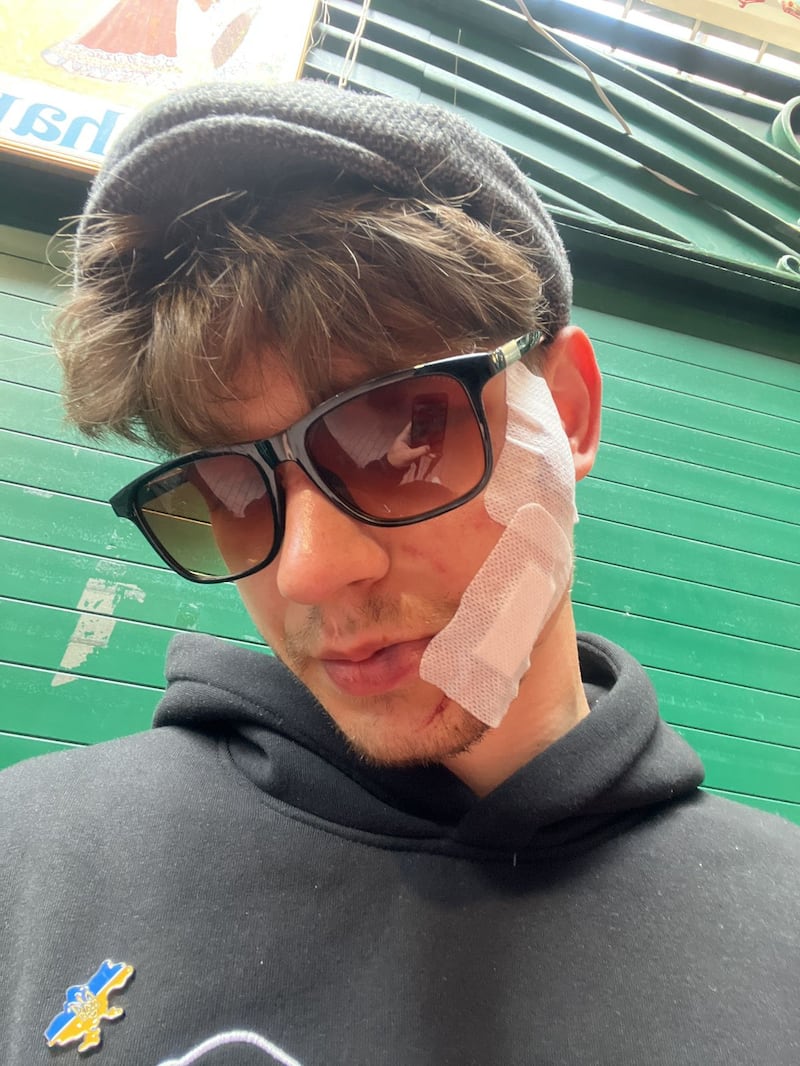The stitched-up wounds down the face of Ukrainian Oleksandr Hrekov were shocking evidence of the ordeal he suffered.
The 23-year-old actor came to Ireland to tread the boards of the Abbey Theatre, an experience that should have offered respite from the war. Instead, Hrekov returned home to Kyiv with a lifelong reminder of his trip to Dublin.
He was set upon, apparently by a five-strong group – two men and three women – on Eden Quay in Dublin city centre, just around the corner from the Abbey, last Saturday night.
He was glassed in the face and bitten. Gardaí believe the attack was unleashed as the group tried to steal the young actor’s cigarettes.
The scene has become depressingly familiar: extreme violence meted out on the streets of Dublin. At times the attacks are filmed by passersby and the clips go viral. Sometimes the assailants are caught. In other cases nothing comes of the follow-up investigation.
There are mixed views among Dublin-based gardaí who speak to The Irish Times on whether violent attacks are increasing. Some say attacks by gangs – often with very serious consequences for the victim – appear to be on the increase.
I think groups were floating around the city centre [during lockdown], drinking and getting a bit wild, and I think that’s continued to an extent
— A Garda source
“You are talking about someone being targeted by several people; being pulverised,” says one Garda member. “I think groups were floating around the city centre [during lockdown], drinking and getting a bit wild, and I think that’s continued to an extent. And we [the Garda] are stretched. They keep saying they are recruiting, but we have seen no sign of that.”
The latest report from Garda Commissioner Drew Harris to the Policing Authority appears to support that contention. Garda College in Templemore, Co Tipperary, closed for much of the pandemic, and recruitment almost completely halted. Garda numbers have been in decline since their peak of 14,750 in March 2020. Two months ago numbers fell below 14,000 for the first time in several years, and last month they fell by a further 70 members, to 13,927. Though recruitment has recommenced, it is slower than expected and has yet to make a positive impact.

Against that backdrop, assaults causing harm have doubled in the past decade across the Republic; from 3,071 offences in 2013 to 6,092 crimes last year. That figure for last year was a record high in the period since the Central Statistics Office assumed responsibility for publishing the Republic’s crime data in 2003. Furthermore, “assaults causing harm” last year were 20 per cent higher than in 2019, before the pandemic.
[ Una Mullally: Dublin is a dirty, smelly, sticky old town once againOpens in new window ]
The trends for other assaults – less serious assaults, often in public places – also reached a new record last year, with 14,001 offences recorded. However, that is only marginally higher than the level seen pre-pandemic; some 13,818 assaults recorded in 2019, for example.
In central Dublin, however, the level of assaults was about the same last year as in 2019. In the first quarter of this year, in four of the six Garda divisions that make up the entire Dublin policing region, assaults were lower than in the same period in 2019.
However, one real concern is the area of south central Dublin policed by Pearse Street Garda station, which last year bucked the trend of mostly flat to lower assault rates elsewhere in the capital.
During the pandemic, when the night-time economy in the area, which includes Temple Bar and much of Camden Street, closed, assaults plummeted. But they surged back last year. Pearse Street recorded 680 assaults and related crimes in 2019, falling to 374 in 2020 and up to a record high of 825 crimes last year.
There is an edge to any city, and there’s definitely an edge in Dublin. And we have gotten to the point where there’s no consequences when you step over that edge
— Social Democrats TD Gary Gannon
Social Democrats TD Gary Gannon is concerned by that trend and, like some gardaí, he is especially worried at the extreme violence of some of the attacks on Dublin’s streets.
“There is an edge to any city, and there’s definitely an edge in Dublin. And we have gotten to the point where there’s no consequences when you step over that edge.”
The city changed during the pandemic period, creating a “hostile environment” where “people up to no good” gained the upper hand “and the guards haven’t gotten control of it since then”, he says.
Overall, Gannon believes a particular style of “metropolitan” policing – aimed specifically at dealing with big-city problems – should be developed for Dublin.
Tony Gallagher is a former Garda inspector who spent much of his 38-year service policing in central Dublin. He retired 12 months ago but he continues to work in the inner city, for Ashtree Rick Group, which helps city-based retailers control risks of thefts, assaults on their staff and “aggressive begging”.
Gallagher says the “promise of high-visibility policing” in central Dublin is “not being delivered upon”, adding that “for a street like O’Connell Street, there should be at least six gardaí deployed there around the clock”.
If the hostels were spread around into the suburbs or they had access to places like the Coolmine [drug treatment] centre – with green spaces, being encouraged to do things like growing crops – they would have a far better chance
— Former Garda inspector Tony Gallagher
During his policing work over many years in central Dublin, the big change was the emergence of a drug-based street culture, he says. He believes there are far too many hostels in central Dublin, including for drug users and former prisoners, as well as methadone clinics.
“The guards can’t move them on because they live in the city,” he says. “And for those people themselves, if the hostels they were staying in were spread around into the suburbs or they had access to places like the Coolmine [drug treatment] centre – with green spaces, being encouraged to do things like growing crops – they would have a far better chance.”
Gallagher believes people with substance abuse issues can recover. But he is adamant housing so many addicts in central Dublin creates a destructive dynamic for such people.
He accepts it may be unpopular to point to hostels, methadone clinics and on-street outreach services as being at the centre of a violent culture on the streets but feels compelled to speak honestly about it.
“We are all thinking it, but nobody is saying it. And if nobody is saying it, nothing gets done,” he says. “You have to comment constructively so the situation changes. You wouldn’t get the same situation around the Champs-Élysées as there is around O’Connell Street.”










